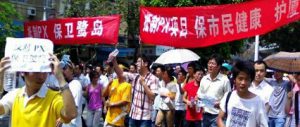This article is adapted from the report China Going Green: A Civil Society Review Of 20 Years Of Sustainable Development, produced by six Chinese NGOs ahead of the Rio+20 summit. Read more here.
Ten years ago, a small delegation of Chinese NGOs went to Johannesburg for the 2002 Earth Summit. For China’s nascent green activist movement, it was something of a milestone – the first time civil-society groups had taken part in international environmental summits. As another Earth Summit rumbles on in Rio de Janeiro, it’s worth taking a moment to reflect on that decade, which has seen some notable successes for civil society, but new challenges too.
The early years of the 2000s were a crucial period for the Chinese public. After the country joined the World Trade Organisation in 2001, there was mounting pressure to bring its laws in line with international practice, including legislation on citizen participation in public decision-making.
The following year, a new, national Environmental Impact Assessment (EIA) Law was published, for the first time making public hearings an official part of the approvals process for new projects. And then, in 2003, crisis and panic over a new and potentially fatal disease originating in south China – SARS – and dissatisfaction with how it was handled, prompted public demands for greater transparency from government.
It seemed like a new dawn for public participation in Chinese policymaking. But a decade down the line, how successful has the push for greater engagement actually been? Views are mixed. Great triumphs like the suspension of hydropower construction on the Nu River and a public hearing on a project in Beijing’s Old Summer Palace have been matched by poor implementation of EIA law and continued frustration of litigants trying to pursue environmental cases through the courts.
An article in the magazine Business Watch described how the Nu River campaign began: “On August 26, 2003, the National Development and Reform Commission examined the Nu River Middle and Lower Reaches Hydropower Planning Report and approved the building of two reservoirs and 13 dams on one of China’s two remaining unspoiled rivers. The plan would see over 102 billion kilowatt hours of electricity generated annually, more than the Three Gorges Dam.”
But, during the meeting – the article continued – an official from the State Environmental Protection Agency “refused to sign the report, as an EIA had not been completed in accordance with the law. After the meeting, the official spoke to Wang Yongchen, founder of environmental NGO Green Earth Volunteers.” This marked the start of a fierce battle to defend the Nu River, led by Chinese campaign groups.
Two later meetings of experts produced further disagreement and deadlock. Meanwhile, NGOs from over 60 nations signed a petition against hydropower on the Nu River and presented it to UNESCO.
In 2004, the tug-of-war finally triggered a high-level response. Premier Wen Jiabao said that “major hydropower projects such as this, which attract a high degree of public attention and different views on environmental protection, must be considered carefully and decisions made scientifically.” His words were effectively a red light, and the plans were shelved. Civil society activists had scored an important victory.
This was the first time China’s environmental NGOs had acted in concert to influence government. But at that time, there were no mechanisms in place to facilitate such a role. Policymaking and public opinion were not linked.
In April 2004, the government published a notice on law-based governance, making government by rule of law a 10-year goal. Aims included “scientific, democratic and standardised mechanisms for administrative policy decisions.” As transparency campaigner Ma Jun has pointed out, “this document went into considerable detail on the right of the public to know and to participate.”
The same year, Pan Yue, then deputy head of the State Environmental Protection Agency, or SEPA (later the Ministry of Environmental Protection) indicated that central environmental authorities wanted to bolster public participation in environmental protection. At the same time, he expressed support for the 10th principle of the Rio Declaration, also known as the Access Principles (See “20 years of China’s public voice” for more on this). Soon afterwards, SEPA appeared to be putting these ideals into practice, when it held the first public hearing since the 2002 EIA law came into effect.
The hearing – on a project to lay an impermeable membrane in the lake at Beijing’s Old Summer Palace – was a breakthrough for public participation in environmental affairs. The government had used a process enshrined in law to bring the public into decision-making. A range of people attended the hearing, and it was broadcast live online.
In 2006, the momentum gathered further, when China published its first document standardising public participation in the environmental sector – the “Temporary Method for Public Participation in Environmental Impact Assessments”. Between that date and April 2007, there was a “storm” of government action. EIAs for 43 projects worth a total of 160 billion yuan (US$25 billion) were rejected. The clout of both NGOs and the environmental authorities increased, to the benefit of both sides.
But six years later, opinions are divided as to the outcome and legacy of that “storm”. Interviewed in 2011, deputy head of Renmin University’s School of the Environment Ma Zhong lamented the weakness of the EIA legislation: “Currently 99% of all China’s capital construction projects pass their EIA. That’s an embarrassing figure.”
And it isn’t the only figure to raise eyebrows. An environment ministry report from June 2010 includes the results of a survey of bodies which had carried out EIAs in 2009: forty percent of those sampled suffered from quality or management problems, while 17% of the reports examined were classed as “quite poor”. Forty EIA workers were criticised by name.
The EIA system, the first policymaking system to involve public participation in China, has been widely scorned. Ma Jun is among the critics: “It should be a mechanism of participation, using democratic policymaking to ensure scientific policymaking. But in China it is often simplified into a system for evaluating technology, and easily loses its effectiveness under the influence of interested parties.”
At a consultation on legislation for pollution permits at Nanjing University in 2010, an official argued that the Chinese public did not have the specialist knowledge needed to express opinions on public policy decisions. Paternalistic attitudes like this are not uncommon; many officials still believe the people are unable to make their own decisions, and need close shepherding.
The Old Summer Palace case provides a good example of government, the NGO sphere and the people working together. But, much more common is a mismatch between resources and need. China is a vast country, with uneven political, economic and social conditions. Where the public is keen to participate and the conditions allow it, the government is often reluctant. Where the government is more open and willing to innovate, there may be fewer environmental problems to resolve, and the result is a lot of fanfare about public participation, but little by way of concrete results.
This kind of mismatch is particularly evident when it comes to defending environmental rights in court. Wang Canfa, director of Beijing-based NGO the Center for Legal Assistance to Pollution Victims (CLAPV), once told reporters: “The defendants in environmental cases are often businesses which create tax income for local governments, and as such they receive open or covert protection.” Often courts will simply refuse to hear a case. Sometimes, documentation is withheld so that the plaintiff cannot appeal.
Xia Jun, a lawyer and member of the environmental committee at the All China Lawyers’ Association, is dispirited by the state of environmental litigation: “Unlike public participation and openness of information, there has been no progress – and in some places things have worsened.”
A trial programme of specialised environmental courts, which started in Wuxi, Guiyang and some cities in Yunnan in 2007, has been more successful than pursuit of lawsuits through the regular channels. Dozens of environmental courts are now operating in more than 10 provinces. But again, there is a mismatch: “Where environmental courts operate, environmental lawsuits are generally better received,” said Xia. “But the problem is that, where pollution is worst, where the need is greatest, there aren’t any environmental courts. The guarantees aren’t in place where they are required the most.”
And, as a result, environmental courts find themselves under more pressure: “Much hope has been placed on these courts, and they have failed to live up to expectations. They have no cases to hear, and just sit around waiting for something to do,” said an official from Yunnan Highest People’s Court in 2011. It wasn’t until October last year that Yunnan’s environmental courts heard a case brought by a grassroots NGO.
These courts have in part been designed to hear precisely these kinds of cases; lawsuits brought in the public interest, by plaintiffs with no direct relationship with the case. In theory, that means that green NGOs can bring lawsuits themselves, and that environmental courts provide a new route for civil society to protect public environmental interests.
The reality is somewhat different. All cases brought by NGOs between 2007 and 2010 involved the All-China Environmental Federation, a group established by the Ministry of Environmental Protection. Participation by the majority of groups founded by the public is still limited.
Chang Cheng is deputy director of Friends of Nature.
This article is published as part of our Green Growth project, a collaboration between chinadialogue and The Energy Foundation.
Homepage image by adopt a negotiator



